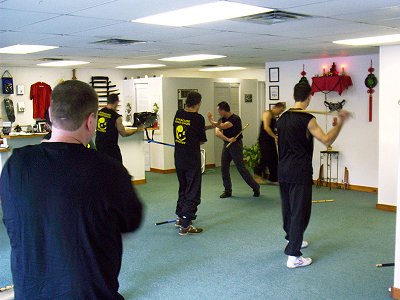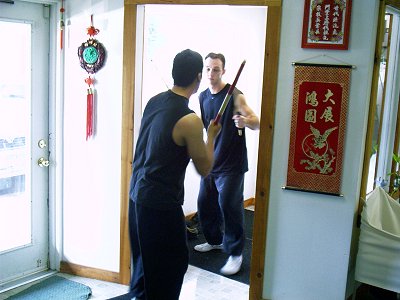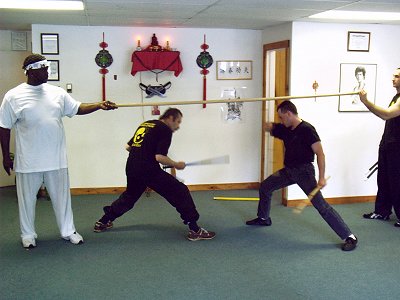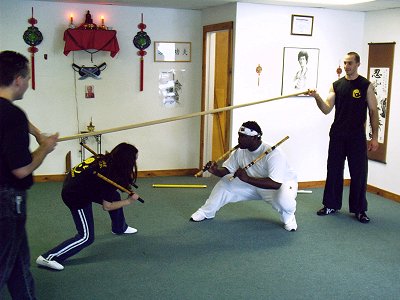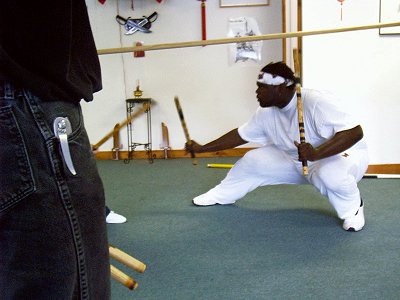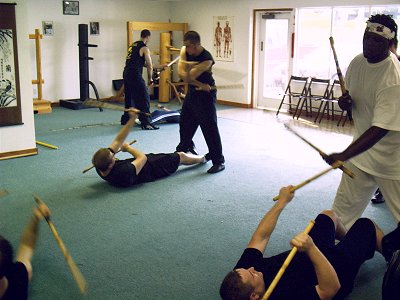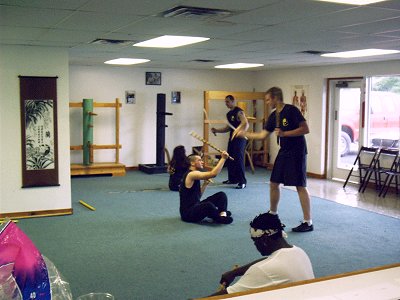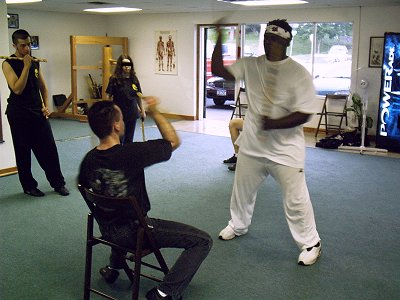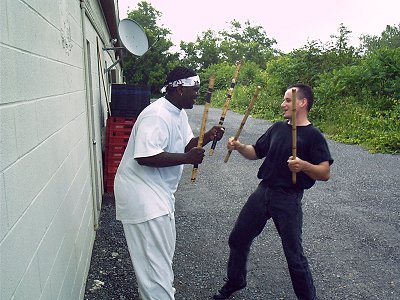its paid sponsors, whose products you need!
| Home |
| Intro |
| Current Issue |
|
Mailing List |
| Store |
| Strength |
| Subscriber Content |
| ARCHIVES
|
| Martialism |
| Pacifism |
| Q & A |
| Cunning-Hammery |
| Advertise With Us |
| Submit An Article |
| Staff |
| Discussion Forum |
| Links |
“Stay ‘unreasonable.’ If you
don’t like the solutions [available to you], come up with your
own.”
Dan Webre
The Martialist does not
constitute legal advice. It is for ENTERTAINMENT
PURPOSES ONLY.
Copyright © 2003-2004 Phil Elmore, all rights
reserved.
Unconventional Stick Training
By Phil Elmore
Many criticisms of contemporary stickfighting
training (be this Kali, Arnis, Escrima, or whatever you want to call it, in
whichever lineage and in whatever school) revolve around the static nature of
some of the training. “Pattern drills,” I have heard it said, “exist to
be smashed.” It is very easy for stick training to devolve into an
elaborate system of patty-cake, with practitioners listlessly moving their
sticks through the same series of movements over and over again. Angles
get sloppy, the orientation of the students’ knuckles start to drift, and the
blade applications of the stick get lost in the rote repetition of an
increasingly meaningless game of two-handed rattan tag.
Assistant instructor “Norm” (background, facing
camera) leads an
intense stick class at the Syracuse Wing Chun Academy.
Take, for example, the shallow walk, a double-stick
drill that beings with high forehand and backhand strikes with each stick,
then to high-low-high strikes on each side, then to Heaven Six, then to
Standard Six, and finally to a redonda variation in which the first striking
stick comes around the back of the head to strike again after the second
striking backhand. This is difficult enough to learn simply as a series
of patterns for beginning students but once learned, it is useless if always
performed as a static series of movements. How, then, does one make
stick training more dynamic, less predictable, and more applicable to
realistic self-defense?
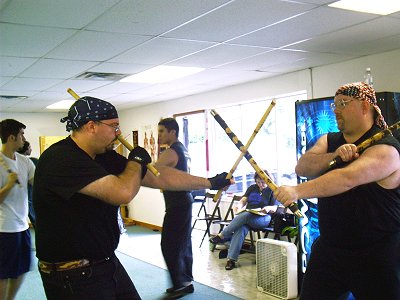
The author (left) works his way through the shallow
walk pattern.
First, let’s be clear
about one thing from the outset: a pattern drill is not a fighting
application. Pattern drills help the practitioner become accustomed to
moving the stick. They develop coordination and help the student to
master, conceptually, the idea of wielding the weapon in specific ways.
In a self-defense scenario, I’m not exactly going to square off against a
would-be mugger and start going through Heaven Six and Standard Six, hoping
he’ll be impressed (while standing there to absorb my blows). No, I’m
going to use simple forehand and backhand strikes, flowing into him and
chopping away at his head, his hands, and his knees. The muscle memory
and weapon familiarity developed in pattern drills will help my limbs perform
those strikes with (one hopes) proper angling and speed.
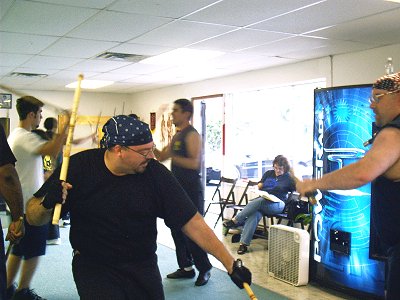
Learning the basics of motion and mobility is just
the beginning.
One simple and extremely effective means of pushing students
out of their comfort zones, while helping them develop the ability to deal
with the unpredictable, is to take something which which they are familiar and
have them perform it in an unfamiliar environment. Once students
know the shallow walk, for example, they could easily become
complacent, perhaps moving faster in the drill but never really doing more
than the same rote motions. We can mix this up by having them perform
the drill while in constant motion, moving around each other, laterally and
forward or back. This is a fairly simple transition to make but then
we make it harder.
First, find a doorway, preferably one you’re to which you’re
not too attached. Have the students perform their drill while moving
into and out of that doorway. They’ll discover that it’s extremely easy
to miss a shot or a block thanks to the close environment. Suddenly,
something to which they’re accustomed because much more difficult thanks to
factors beyond their control. They’ll start to learn to position
themselves for tactical superiority, using the obstructions to make their
opponents’ tasks more difficult while making their own easier.
A doorway is an obstruction that does not change, in that it is
always in the same place. Next, students perform their pattern drills
while coping with a constantly shifting barrier. The most expedient of
these is a “roof” made of a simple staff such as a long “dragon pole.”
Students performing a pattern drill under a pole
barrier.
Dealing with a low ceiling prevents problems even in static
training. The ceiling panels at our school bear the scars of many a
class and boast marks made by an impressive diversity of weapons. While
students perform their drill and try not to make contact with the pole
barrier, the partners holding the barrier begin to raise and lower it at
random.
The pole barrier is raised and lowered at random as
students practice.
Students performing a drill under these conditions must learn
to lower their bodies and modify their footwork accordingly, all while
performing their strikes and blocks. Missing a block means taking a
painful shot from the stick. As the variables increase, the brain
teeters on the edge of (or goes over into) overload. This is a good
thing; it forces you to stop thinking about what you must do
prompts you simply to do it, relying on your training and instincts.
We must not lose sight of what we are doing. We
are training the
the stick in order to more effectively wield the blade.
Performing pattern drills with a lack of parity also increases
variables and force students to learn to apply their skills in different
contexts. Have one student in each pair perform the drill while lying
prone on the floor, or while sitting up, or while sitting in a chair.
The angles change for the partner who is standing, while for the other partner
the mechanics of using the sticks must be modified.
Changing parity: students practice with one
partner on the floor…
…with one partner sitting up…
…and with one partner fighting from a chair.
Once students have learned to perform their drills in varied
environments, you can get more “freestyle” with the exercise, going outside
and ranging all across the available training space. Learning to
maneuver one’s opponent into positions of environmental disadvantage is an
extremely important, extremely useful skill for realistic self-defense.
Norm “right” has just finished working his partner
into a wall.
Simply changing the number and type of variables with which
students must deal greatly improves any training. As we apply familiar
skills in an unfamiliar context, we learn to adapt and to cope with the
unpredictable. It is vital that we do this in training in order to apply
it in self-defense.
Self-defense, after all, is nothing if not unpredictable.

